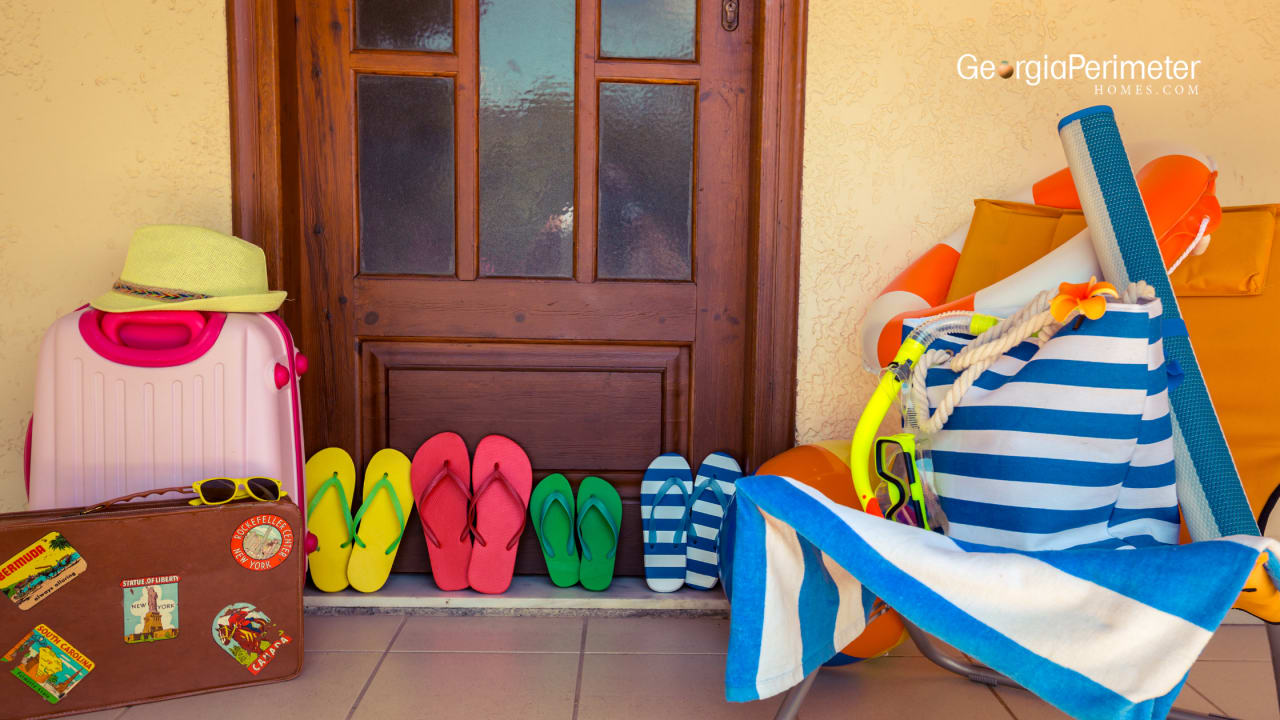What do frozen pipes, skidding tires, and high heating bills have in common? They’re all winter-weather nuisances that can be avoided with adequate preparation. If you use these strategies to winterize your home, garden, car, and personal care routine, no amount of snow or ice will spoil your enjoyment of the season.
Tend to tree branches
Winter storms can deposit heaps of tree branches onto your roof. These can then snap under the weight of snow or ice and go on to pierce holes in your roof, loosen shingles, or get swept onto a neighboring roof where they can cause damage. To avoid surprise leaks in your (or your neighbor's) roof, periodically prune branches that hang over the house, and use a roof rake to clear away any branches that fall onto the roof. (Call in an arborist if the job's too big for you.)
Safeguard Spigots
Even after you turn off an outdoor spigot, water that lingers in an attached garden hose can freeze and cause pipes behind the spigot to burst, spouting water into your house. Always disconnect and drain garden hoses after using the spigot in cold weather, and consider shutting off the valve inside the house to protect your pipes.
Clear out Gutters
When your gutters become blocked with leaves or twigs, snow and ice that would ordinarily get directed away from the house will collect (and eventually melt) on the roof or run off onto the ground, leading to rotting fascia boards boards below the roofline, cracks in the foundation or walkways, or leaks in the basement. To avoid costly structural damage, inspect and, if needed, clean your gutters before the first freeze. Use a trowel or scoop for large debris, and rinse away smaller debris with a garden hose.
Wrap Exposed Pipes
Gifts aren’t the only thing you’ll want to wrap up this winter. Many unsuspecting homeowners have gone out of town during a particularly cold stretch only to return to a flood caused by an exposed pipe that froze and burst. Wrap insulation sleeves around pipes that run through unheated areas, such as attics and crawl spaces, to protect pipes from freezing and heat loss—and keep your home dry and your heating bill low.
Seal Gaps and Other Openings
Applying caulk or weatherstripping to drafty windows and doors can keep the cold out and the heat in, maximizing indoor comfort and saving you anywhere from 5 to 10 percent in energy costs, according to the U.S. Department of Energy. Sealing up gaps can also prevent melted ice or snow from rotting exterior features. So, take a day before the temperatures dip to caulk joints between walls and window frames and door frames, and place weatherstripping around window sashes.
Insulate Walls & Attics
An underinsulated home is subject to cold spots and higher heating bills, while a properly insulated home enjoys evenly distributed warmth, increased indoor comfort, and energy savings. The most effective places to insulate are exterior walls, attics, and unheated garages, but it's important to find and repair any leaks in those areas before adding batt, spray-foam, loose-fill, or blown-in insulation.
Bundle up your water heater
Have an older hot water heater? If its R-value is less than 24 (or if it’s warm to the touch), consider wrapping it with a water heater insulation blanket designed to fit your size tank. Made of materials that range from foil to fiberglass, these flexible accessories are like a jacket for your water heater—and they can reduce heat loss by 25 to 45 percent. With the 7 to 16 percent you’ll save in energy costs, you can recoup the purchase price of the blanket in less than a year.
Focus on the Fireplace
If you haven’t had your chimney inspected this year, have a CSIA-certified chimney inspector give it a once-over before your first burn of the winter to eliminate creosote (a flammable, sooty buildup) or obstructions that can spark chimney fires. When the fireplace isn’t in use, close the damper above the firebox to keep warm indoor air from escaping and cold air from entering the house through the chimney.
Reverse the fan blade direction
If your fan blades are still set to turn counterclockwise, the warm air you crave will float to the ceiling, while cold air will get pushed down toward the floor level where you are. To avoid wintertime chills, switch your fans to rotate clockwise so that the blades will push warm air down to you.
Lay off the lawn
Before the first frost, it’s important to aerate the lawn—punch holes into it—to allow the soil to breathe after all the natural compaction that has occurred over the past year. This can be done with an aerator, a tool with spiked tines that pierce the soil, or, for larger lawns, with an electric- or gas-powered aerator or one that can be towed behind a lawn mower. But once your turf has gone dormant for the winter, keep kids, pets, and equipment off it as much as possible; heavy traffic can damage the turfgrass crowns that grow at soil level, resulting in bare patches of grass in spring.
Have your car serviced
A car breakdown is unwelcome at any time of year, but it’s positively horrible when you have to prop open the hood and diagnose the problem in freezing temperatures. To avoid getting stranded in the cold, check your car's manual to see if you’re due for a service, and be sure to make that appointment before the first freeze. If you can’t afford to make all recommended repairs, focus on the battery, brakes, cables, spark plugs, and tires.
Keep Ice Melt in the Trunk
You can't wait for snow to thaw before you hit the road, so be sure to keep ice melt, such as a bag of rock salt, in the back seat of your car (not in the trunk, which can freeze shut). Having ice melt close at hand means you're always ready to take care of ice on walkways and driveways to help prevent nasty slips, falls, or car accidents. Carry sand as well—you can throw it over the salt to provide needed traction when you're trying to get your car out of an icy spot.
Winterize your wheels
If you regularly venture out into heavy snow, consider swapping your traditional tires for a set of snow tires, which feature treads with large gaps that help improve traction. To preserve the tread on snow tires, wait until daytime temperatures are consistently 50 degrees F or below to install them. In addition to (or in place of) snow tires, consider tire socks, which are fabric tire covers that slip over your tire like a sock and perform almost as well as—and sometimes better than—snow tires when decelerating on slick surfaces, according to Consumer Reports.
Pack an emergency kit
Winter storms can descend unexpectedly when you're on the road. Always carry a winter emergency kit in the trunk of your vehicle so you'll be prepared, no matter what Mother Nature throws your way. The kit should contain everything you need to cope with a sudden breakdown and the stranding that could result. At minimum, pack a flashlight (and extra batteries), road flares, jumper cables, a first aid kit, a small supply of snacks that won’t freeze (for instance, chips or cookies), and winter accessories including gloves, boots, and a blanket.
Install Winter Hardy Windshield Wipers
While an ice scraper and a spray bottle of homemade de-icer are two time-honored ways of clearing up an icy windshield, both require that you get out of your vehicle and face the brutal cold. It's safer—and warmer—to install winter windshield wiper blades, whose flexible rubber and anti-clogging arms will help fend off snow and ice as you sit comfortably in your warm car.
Minimize Driving
When the streets are slick, home is the safest place to be. But if you must drive, inform close contacts of your whereabouts and keep to major roads; back roads are not only less frequently salted or plowed (if at all) but also contain insufficient signage, which can easily lead you astray during a winter storm.
Evaluate Roadside Resources
Seventy percent of winter-weather injuries happen in cars, according to the National Severe Storms Laboratory. That trusty family member or friend may not always be able to rush to your aid during a roadside emergency, so it’s a good idea to enroll in an automotive club or a roadside assistance program from your car insurance company or another provider. If you opt for any of these services, keep the customer support number in your phone contacts so it's always at your fingertips in time of need.
Tweak the Thermostat
If you like toasty indoor temperatures but can’t afford high heating bills, acclimate yourself to a lower, more energy-efficient thermostat setting, starting with 72 degrees F and then gradually reducing it down to 68 degrees F as you adapt to the change. A one-degree reduction in the thermostat setting can reduce your heating bills by 1 percent if maintained for eight hours, according to Direct Energy. With a few layers of clothing on, you may never even notice the temperature difference. Even better, if you’re away from home by day or can make do with less heat as you sleep, you can boost the cost savings by bumping the thermostat down to 62 to 66 degrees F.
Use a Humidifier
Even with the thermostat set to moderate temperatures, central heating can quickly evaporate the moisture in your skin, leaving it dry and flaky. Invest in a humidifier—a device that emits water vapor to increase the moisture of surrounding air—to help you maintain supple skin that glows all winter long. Regularly clean the humidifier according to the manufacturer’s instructions to prevent the growth of bacteria.
Reduce the Temperature and Duration of your shower
A long, piping-hot shower may be tempting on a bitterly cold day, but the high temperature can dry out your skin and aggravate skin conditions including eczema or psoriasis, and the extra soak time can spike your water bill. Keep your skin hydrated and your costs low by limiting showers to five minutes in warm (not hot) water.
Source: https://www.bobvila.com/slideshow/the-21-best-ways-you-can-prepare-for-a-frigid-winter-53180

















































